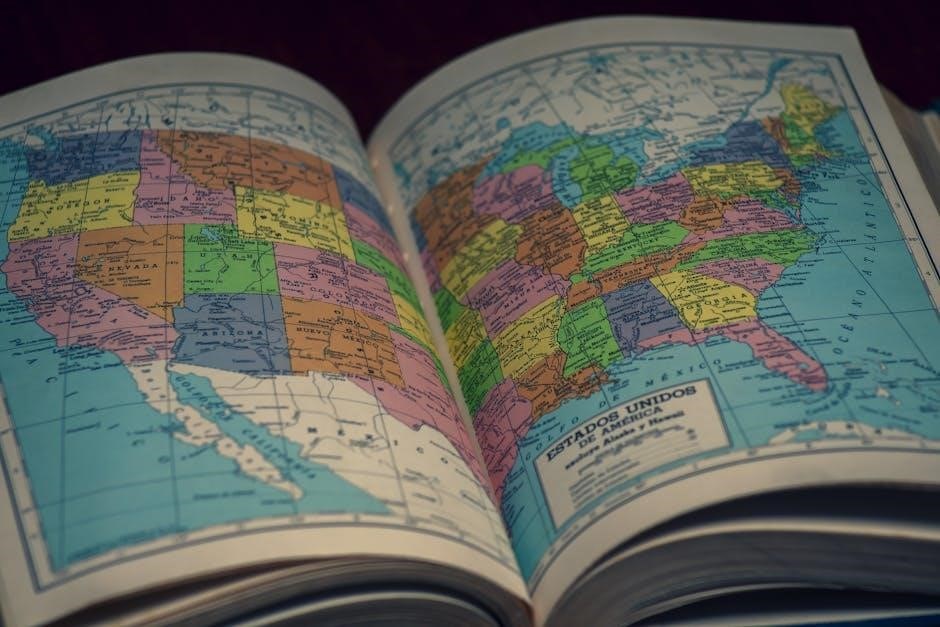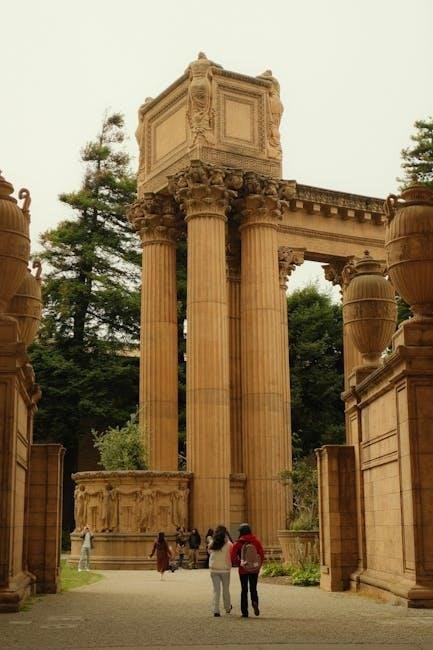Transoceanic interconnections refer to the maritime routes and cultural exchanges that linked distant regions across the world’s oceans. These connections‚ spanning ancient to early modern periods‚ facilitated the exchange of goods‚ ideas‚ and cultures‚ reshaping societies and laying the groundwork for globalization.

Key Explorers and Their Voyages
The Age of Exploration was defined by courageous explorers who embarked on perilous voyages‚ reshaping global connections. Christopher Columbus’s 1492 voyage across the Atlantic opened the Americas to European influence. Vasco da Gama reached India in 1498‚ establishing a sea route from Europe to Asia. Ferdinand Magellan’s circumnavigation of the globe (1519–1522) proved the Earth’s roundness and expanded Spanish dominance. Other notable figures include Henry the Navigator‚ who sponsored early Portuguese explorations‚ and Juan Ponce de León‚ who explored Florida. Explorers like Hernán Cortés and Francisco Pizarro played roles in the conquest of the Aztec and Inca empires‚ respectively. These voyages were driven by the quest for wealth‚ new trade routes‚ and the spread of Christianity. Their journeys not only expanded geographical knowledge but also initiated profound cultural and economic exchanges‚ laying the foundation for European colonization and global interdependence.
Columbian Exchange
The Columbian Exchange was a widespread transfer of plants‚ animals‚ culture‚ and diseases between the Americas and the Old World (Europe‚ Africa‚ and Asia) following Christopher Columbus’s voyages. This exchange revolutionized diets‚ economies‚ and societies globally. Crops like maize‚ potatoes‚ and beans were introduced to the Old World‚ boosting food production and population growth. In return‚ Europeans brought wheat‚ horses‚ and livestock to the Americas‚ transforming local agriculture and transportation.
Diseases‚ however‚ had devastating effects. Indigenous populations‚ lacking immunity to Eurasian diseases like smallpox and influenza‚ suffered massive declines. This demographic collapse reshaped the Americas socially and politically. The Columbian Exchange also facilitated cultural exchanges‚ blending traditions and creating new identities. It laid the foundation for globalization‚ connecting previously isolated regions and fostering interdependence. This period marked the beginning of profound changes that continue to influence the world today.

Social and Cultural Impacts
Transoceanic interconnections profoundly shaped social and cultural landscapes worldwide. The blending of cultures‚ traditions‚ and ideas led to the creation of new identities and practices. For instance‚ the spread of languages like Spanish and Portuguese in the Americas and the introduction of Christianity reshaped indigenous societies.
Indigenous populations faced significant disruptions to their social structures‚ often leading to the loss of traditional practices. However‚ syncretic practices emerged‚ blending indigenous and European beliefs. The exchange of goods also influenced daily life‚ with new foods and technologies altering cultural norms and customs.
The movement of people‚ including European settlers and enslaved Africans‚ further enriched cultural diversity. This intermixing laid the foundation for multicultural societies. Despite challenges‚ these interactions fostered resilience and adaptability‚ leaving a lasting legacy in the modern world.
Religious Impacts
Transoceanic interconnections had profound religious impacts‚ reshaping belief systems across the globe. European explorers and missionaries introduced Christianity to the Americas‚ Africa‚ and Asia‚ often displacing indigenous religions. This led to the widespread conversion of native populations‚ though syncretism often emerged‚ blending local traditions with Christian practices.
In the Americas‚ indigenous spiritual practices were suppressed‚ and Catholicism became dominant. Similarly‚ Islam spread in parts of Africa and Asia through trade and cultural exchange. The exchange also facilitated the movement of religious ideas between Europe and Asia‚ such as the influence of Islamic scholarship on European thought.
Religious conflicts arose‚ particularly in regions where European powers imposed their beliefs. However‚ the interconnections also fostered tolerance in some areas‚ as diverse cultures interacted. The legacy of these religious transformations is evident in the multicultural and multireligious societies of today.

Economic Impacts
Transoceanic interconnections significantly reshaped global economies‚ creating new trade networks and wealth distribution systems; The exchange of goods such as spices‚ metals‚ and crops transformed regional economies‚ with Europe benefiting greatly from the influx of resources like gold‚ silver‚ and agricultural products from the Americas.
The Columbian Exchange introduced crops like maize‚ potatoes‚ and cassava to Europe‚ boosting population growth and agricultural productivity. Conversely‚ Europe exported goods such as horses‚ cattle‚ and firearms‚ which revolutionized economies in other regions. The establishment of triangular trade systems‚ including the transatlantic slave trade‚ further integrated global markets but at a devastating human cost.
Colonial exploitation enriched European powers‚ enabling them to invest in technological advancements and expand their empires. The rise of joint-stock companies and the beginnings of capitalism were direct outcomes of these economic interconnections. However‚ indigenous populations often suffered from resource depletion and unequal trade practices.
Overall‚ transoceanic interconnections laid the foundation for modern global economic systems‚ emphasizing the interconnectedness of wealth and resources across vast distances.

Rise of Global Empires
The transoceanic interconnections facilitated the rise of global empires‚ particularly European powers such as Spain‚ Portugal‚ Britain‚ France‚ and the Netherlands. These empires expanded their influence by establishing colonies‚ trading posts‚ and maritime dominance‚ reshaping the political and economic landscapes of vast regions.
European explorers and conquistadors‚ driven by the quest for wealth‚ territorial control‚ and religious missionary work‚ established vast empires in the Americas‚ Africa‚ and Asia. The Spanish and Portuguese empires were among the first to emerge‚ benefiting from the riches of the New World and the establishment of the encomienda system.
As European powers competed for dominance‚ they developed sophisticated administrative systems to govern their overseas territories. The creation of viceregal systems in the Americas and fortified trading posts in Asia allowed these empires to maintain control and extract resources efficiently.
The rise of global empires also led to the transfer of political ideologies and legal frameworks to colonized regions. Indigenous populations often resisted imperial rule‚ leading to conflicts and uprisings. Despite this‚ the empires persisted‚ laying the foundation for modern nation-states and global power dynamics.
By the 18th century‚ the balance of power began to shift‚ with Britain emerging as a dominant force. The legacy of these empires continues to influence contemporary international relations and cultural identities.
Decline of Indigenous Populations
The transoceanic interconnections had devastating effects on indigenous populations worldwide. The introduction of European diseases‚ such as smallpox and influenza‚ decimated Native American populations‚ who had no immunity to these illnesses. This demographic collapse weakened indigenous societies.
Violence and displacement further contributed to the decline. European colonizers often displaced indigenous peoples from their lands‚ leading to loss of resources and cultural disruption. Enslavement‚ forced labor‚ and massacres were common‚ particularly in regions like the Caribbean and the Americas.
The disruption of indigenous social structures and traditions exacerbated the decline. Many indigenous leaders were killed or deposed‚ leading to political instability. Additionally‚ the imposition of European religious and cultural practices eroded indigenous identities and ways of life.
In some regions‚ indigenous populations were entirely wiped out due to the combined effects of disease‚ violence‚ and exploitation. This decline reshaped the demographics of affected regions‚ creating a labor vacuum that European colonizers filled with enslaved Africans.
The long-term consequences of this decline are still felt today‚ with many indigenous communities continuing to struggle for recognition and rights. The legacy of this period remains a critical topic in understanding global history and its impact on marginalized peoples.
For effective study‚ focus on key explorers‚ their voyages‚ and the consequences of their discoveries. Pay attention to the Columbian Exchange‚ including the transfer of plants‚ animals‚ and diseases. Analyze the social‚ cultural‚ and economic impacts on both colonizers and indigenous peoples.
Review the decline of indigenous populations due to disease‚ violence‚ and displacement. Examine how global empires expanded and the role of trade in shaping economies. Use timelines to track major events and compare primary sources for diverse perspectives.
Practice essay questions by addressing causes and effects of transoceanic interconnections. Focus on clear thesis statements and supporting arguments with specific examples. Engage with study groups to discuss complex topics and review key terms regularly.
Lastly‚ reflect on the legacy of these interconnections in modern global dynamics. This holistic approach will enhance your understanding and prepare you for assessments effectively.



